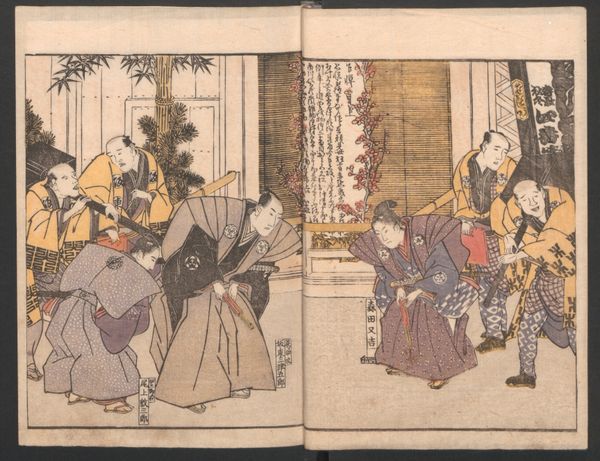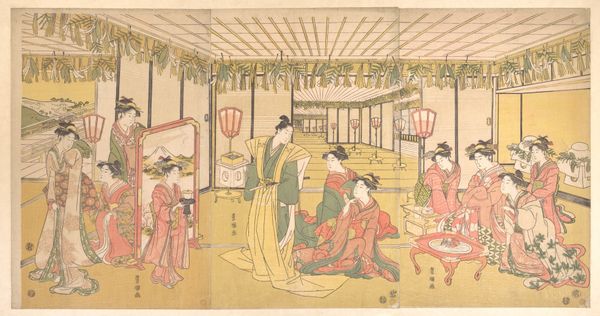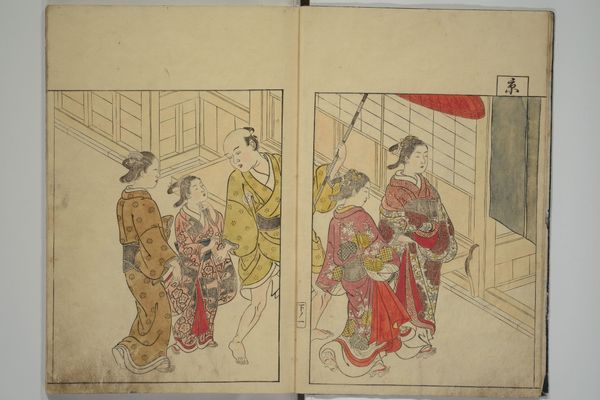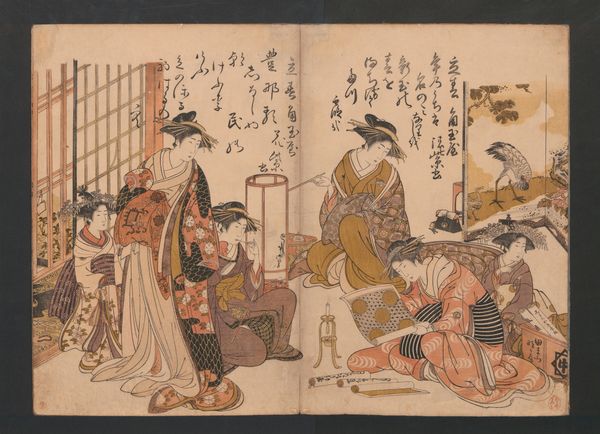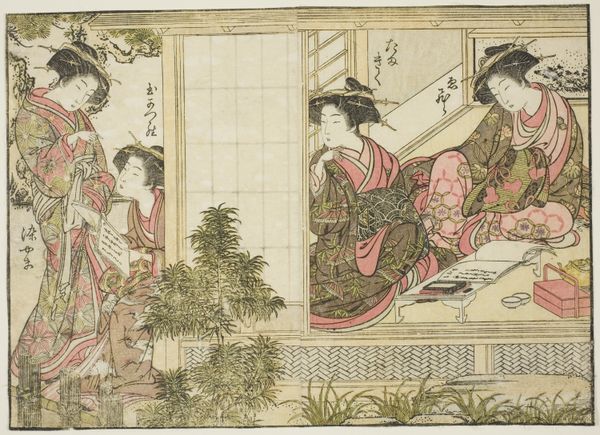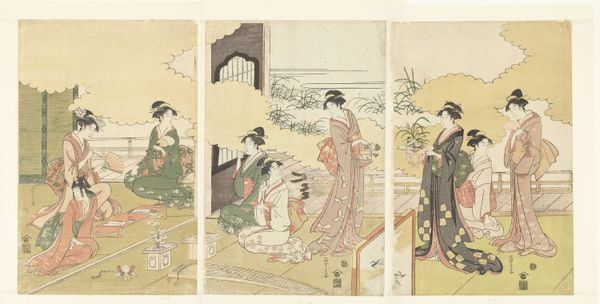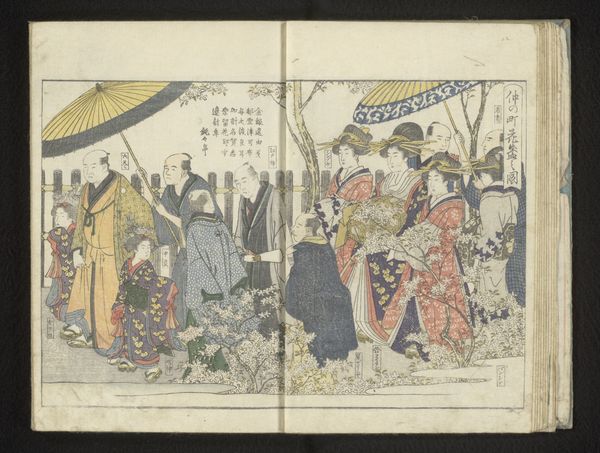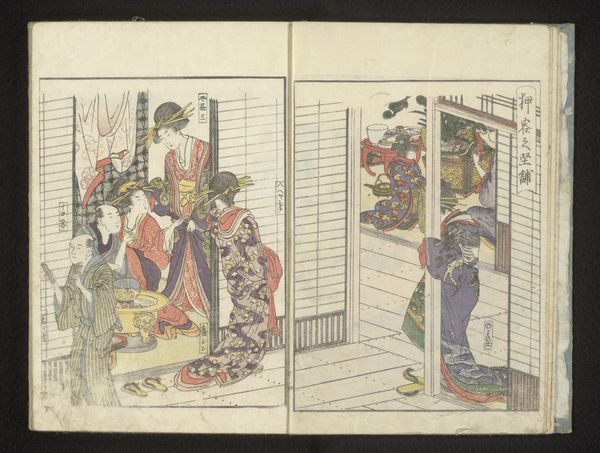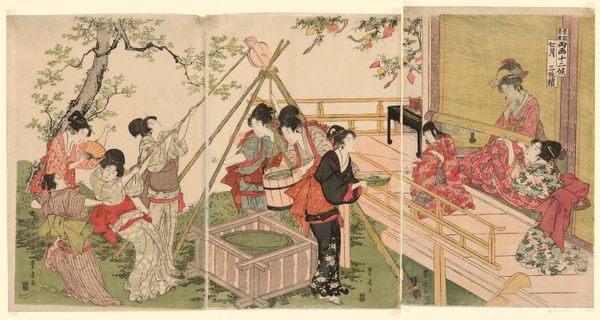![Amusements of Kabuki Actors of the “Third Floor” [Dressing Room], by Shikitei Sanba by Utagawa Toyokuni I](/_next/image?url=https%3A%2F%2Fd2w8kbdekdi1gv.cloudfront.net%2FeyJidWNrZXQiOiAiYXJ0ZXJhLWltYWdlcy1idWNrZXQiLCAia2V5IjogImFydHdvcmtzLzhhOTlmZDM3LTFiNTMtNDY1MS04MWU5LWVhMGIyMmFiNjEwOC84YTk5ZmQzNy0xYjUzLTQ2NTEtODFlOS1lYTBiMjJhYjYxMDhfZnVsbC5qcGciLCAiZWRpdHMiOiB7InJlc2l6ZSI6IHsid2lkdGgiOiAxOTIwLCAiaGVpZ2h0IjogMTkyMCwgImZpdCI6ICJpbnNpZGUifX19&w=3840&q=75)
Amusements of Kabuki Actors of the “Third Floor” [Dressing Room], by Shikitei Sanba 1801
0:00
0:00
#
portrait
# print
#
asian-art
#
ukiyo-e
#
figuration
#
genre-painting
Dimensions: 8 7/16 × 6 1/8 in. (21.5 × 15.5 cm)
Copyright: Public Domain
Curator: Wow, look at all that action! I'm immediately drawn to this backstage frenzy. The expressions! They tell a story of nervous anticipation before the show. Editor: Indeed. Here we have an 1801 print, "Amusements of Kabuki Actors of the Third Floor [Dressing Room]" by Shikitei Sanba, currently housed at the Metropolitan Museum of Art. It's an exquisite example of ukiyo-e genre painting capturing the behind-the-scenes world of kabuki theatre. Curator: It feels so intimate, doesn't it? Almost voyeuristic. What power dynamics do you sense happening here, aside from performance? Are the hierarchies implied? Editor: Absolutely. Note how the central figures—presumably the actors—are framed. The gaze suggests gendered social norms and the highly formalized space within kabuki traditions. We could unpack questions of labor, leisure, and representation by centering those observations. What are your thoughts about this aesthetic, its formal structure, and socio-cultural roots? Curator: Visually, the composition leads my eye to the minute details— the intricate kimono patterns, the varying emotions etched on their faces. These details, so subtly rendered, feel deliberate. As to structure and roots, ukiyo-e prints held significant influence as sources for conveying socio-cultural messages. That the artist's work persists is perhaps indicative of its resonance within our shared experiences. Editor: And its subversive appeal for many audiences, across cultural and temporal contexts! It's interesting to observe how seemingly informal these “amusements” actually appear to be, knowing as we do that this milieu would have also represented intensive, regimented work. Curator: Definitely not all fun and games behind the stage! This makes you ponder the nature of artistic depictions, don’t you think? Are there particular actors we can identify through portraiture? Editor: Indeed, there are some clues; we would need to conduct more thorough iconographic research, though, of the kinds available through publications or museum curatorial archives. Anyway, the point to be made may not so much rely on accurate portrayal of known performers so much as how the work contributes to a genre of performance studies within Edo society. Curator: Precisely! Thanks for highlighting all this; now when I see it I'm thinking about layers of identity, theater production and the political climate within which artistic liberties were being forged. Editor: A potent reminder, really, that artworks are never viewed in isolation. And my take? Well, this piece confirms that behind every grand spectacle, there are complex narratives that we get a small glimpse into.
Comments
No comments
Be the first to comment and join the conversation on the ultimate creative platform.
